Military Medal
| Military Medal | |
|---|---|
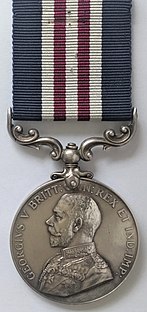 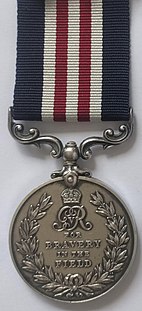 Obverse and reverse of medal and ribbon | |
Awarded by UK and Commonwealth | |
| Type | Military decoration |
| Eligibility | British and (formerly) Commonwealth forces |
| Awarded for | Acts of gallantry and devotion to duty under fire |
| Status | Discontinued in 1993 |
| Statistics | |
| Established | 25 March 1916 (backdated to 1914) |
| Order of Wear | |
| Next (higher) | Distinguished Service Medal[1] |
| Next (lower) | Distinguished Flying Medal[1] |
| Related | Military Cross |
Ribbon bar Ribbon bar with rosette to indicate second award | |
The Military Medal (MM) was a military decoration awarded to personnel of the British Army and other services, and formerly also to personnel of other Commonwealth countries, below commissioned rank, for bravery in battle on land. The award was established in 1916, with retrospective application to 1914, and was awarded to other ranks for "acts of gallantry and devotion to duty under fire". The award was discontinued in 1993 when it was replaced by the Military Cross, which was extended to all ranks in the British honours system, while other Commonwealth nations instituted their own awards systems in the post war period.
Contents
1 History
2 Description
2.1 Obverse variations
3 Notable recipients of the Military Medal
4 Popular culture
5 See also
6 References
7 External links
History
The medal was established on 25 March 1916.[2] The MM was awarded to other ranks including non-commissioned officers and warrant officers. It ranked below the Distinguished Conduct Medal (DCM), which was also awarded to other ranks including non-commissioned officers and warrant officers.[3]
When the medal was first introduced, it was unpopular among regular soldiers wrote MM and DCM recipient Frank Richards who stated "the Military Medal, which without a shadow of a doubt had been introduced to save awarding too many DCMs. … The old regular soldiers thought very little of the new decoration".[4] Both the DCM and the MM attracted a gratuity and the decoration allowance of an extra sixpence a day to veterans with a disability pension. However, decoration allowance was only awarded once even if the recipient like Frank Richards DCM MM was awarded more than one gallantry award. The ratio in the First World War was approximately five MMs awarded for every DCM.[5]
Recipients of the DCM from its creation in 1854 and the MM from its creation in 1916 were not entitled to the post-nominal letters "DCM" or "MM" until 1918.[6][7] Over 115,000 awards of the MM were made for actions during the First World War. Additionally, over 5,700 bars were awarded, as well as 180 second bars. There was one instance of a third bar being awarded;[7] this was made to Private Ernest Albert Corey, who served as a stretcher bearer in the 55th Australian Infantry Battalion, which served on the Western Front.[8] During the Second World War, over 15,000 awards of the MM were made.[7]
Eligibility for the MM was extended, by a Royal Warrant dated 21 June 1916, to women whether British subjects or foreign with the first awards gazetted on 1 September 1916. Although nurses of the Queen Alexandra’s Imperial Military Nursing Service (QAIMNS) and the Territorial Force Nursing Service (TFNS) and other women serving with the British Army were treated as officers, they were not officers and ineligible for the Military Cross but could and were awarded the MM. Honorary MM awards to foreigners were not gazetted but at least 5,688 to recipients of 11 allied countries in the First World War and 660 to recipients of ten allied countries in the Second World War have been identified.[9]
In 1993, the Military Medal was discontinued. Since then, the Military Cross has been awarded to personnel of all ranks within the British honours system.[8] The MM had been awarded by Commonwealth countries, but by 1993 most had established their own honours systems and no longer recommended British honours.[8][10][11]
Description
The medal and ribbon had the following features:[3][7]
- A circular silver medal of 36 mm diameter. The obverse bears the effigy of the reigning monarch and an appropriate inscription.
- The reverse has the inscription "FOR BRAVERY IN THE FIELD" in four lines, surrounded by a laurel wreath, surmounted by the Royal Cypher and Imperial Crown.
- The suspender is of an ornate scroll type.
- The ribbon is dark blue, 1.25 inches wide, with five equal centre stripes of white, red, white, red, and white (0.125 inches each).
- Silver, laurelled bars were authorised for subsequent awards, with a silver rosette worn on the ribbon bar to indicate the award of each bar.
Obverse variations
The medal was awarded with one of six obverse designs:[9]
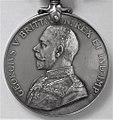
George V (1st type) In Field Marshall's uniform (1916-1930)

George V (2nd type) In crown and robes (1930–1937)
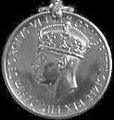
George VI (1st type) Inscription has 'INDIAE IMP' (1938–1948)

George VI (2nd type) Omits 'INDIAE IMP' (1949–1952)
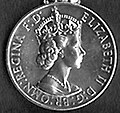
Elizabeth II (1st type) Inscription has 'BR OMN' (1952–1958)
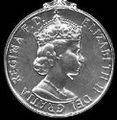
Elizabeth II (2nd type) Inscription has 'DEI GRATIA' (1958–1993)
Notable recipients of the Military Medal

French soldiers, after having been awarded the Military Medal, Battle of the Somme 1916
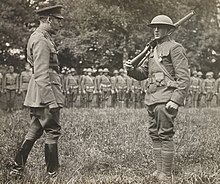
King George decorating a US soldier with the Military Medal in 1918
Over 135,000 people have been awarded the Military Medal. Among the more notable recipients are:
Ian Bailey, who was awarded the medal as a Corporal in The Parachute Regiment during the Falklands War, and went on to become a Captain.
Billy Bennett, British comedian.
Geoffrey Bingham, Australian theologian and author.
Walter Bingham, Jewish refugee from Nazi Germany who served in Normandy and subsequently in Counter Intelligence.
Joe Cassidy, Scottish footballer.
Mairi Chisholm, British volunteer ambulance driver.
Douglas Clark, British rugby league footballer and wrestler.
Jack Clough, British footballer.
Jack Cock, British footballer.
William Coltman, who was also awarded the Victoria Cross, and was the most highly decorated NCO of the First World War.
Robert Gaspare Consiglio, Special Air Service member killed during Bravo Two Zero patrol, Iraq 1991.[12]
Ernest Albert Corey, the only person to be awarded the MM four times.[8]
Dorothie Feilding, first woman to be awarded the MM.
Barney F. Hajiro, Japanese American soldier and Medal of Honor recipient, awarded for his actions in the Second World War.
Billy Hanna, Northern Irish loyalist and commander of the Ulster Volunteer Force's Mid-Ulster Brigade, for gallantry in the Korean War.
William Hutt, Canadian actor.
Fred 'Buck' Kite, the only British soldier to be awarded the MM and two Bars in the Second World War.
Elsie Knocker, British volunteer nurse and ambulance driver.
Steven John Lane, Special Air Service member killed during Bravo Two Zero patrol, Iraq 1991.[12]
Bob Lilley, founding member of the British Special Air Service, one of the "Tobruk Four".
Norman Washington Manley, former First Minister of Jamaica, sergeant in the British Army during the First World War.
John McAleese, former British Special Air Service soldier who helped end the Iranian Embassy siege in 1980.
James McCudden, the most highly decorated British pilot of the First World War.
Richard McFadden, professional footballer with Clapton Orient, who was killed on the Somme on 23 October 1916.
Andy McNab (pseudonym), former Special Air Service soldier and author.
Francis Pegahmagabow, Canadian Expeditionary Force, Canadian Aboriginal Veteran, Canada's most highly decorated aboriginal soldier of the First World War, who was awarded 2 additional bars to his Military Medal.
Tommy Prince, Devil's Brigade, Canadian Aboriginal Veteran, Canada's most decorated aboriginal soldier of the Second World War, who also received the US Silver Star.
Bob Quinn, leading Australian rules footballer.
Frank Richards, who wrote about his wartime experiences, and who received both the DCM and the MM.
Charles Rutherford, awarded the Military Cross, Military Medal and Victoria Cross.
Chris Ryan (pseudonym), British Special Air Service sergeant and author.
Wilfred Sénéchal, New Brunswick, Canada lawyer, politician.
Karam Singh, Indian soldier later awarded the Param Vir Chakra, India's highest military decoration
Al Slater, Special Air Service soldier killed in action. Appeared on British documentary The Paras.
Randall Swingler, British poet.
Willie Thornton, Rangers and Scotland footballer.
Violetta Thurstan, nurse in World War One, evacuated wounded soldiers while under fire.
Karl Vernon, Olympic medallist oarsman and coach.
Arthur Wesley Wheen, translator of All Quiet on the Western Front.
Arch Whitehouse, World War I RAF Officer.
Major-General F. F. Worthington was awarded the Military Medal for actions near Vimy Ridge.
Langford Wellman Colley-Priest, Australian stretcher-bearer
Popular culture
In the BBC series, Peaky Blinders, the principal protagonist/ anti- hero Thomas Michael Shelby is a recipient of the Military Medal.
In Soldier Soldier, broadcast on ITV, at the 50th D Day Anniversary, Robson Green's character, Fusilier Dave Tucker, gets a veteran called Jack Knight talking, who subsequently turns out to be a recipient of the Military Medal.
In the Dad's Army episode Branded, the platoon discover that the character Private Godfrey was a Conscientious Objector. He is then ostracized by the platoon, until they find that he won the Military Medal in the First World War whilst serving in the Royal Army Medical Corps, for rescuing wounded men under enemy fire. The medal itself is central to the storyline in that it is higher than all the medals held by the rest of the platoon and is seen as a mark of true heroism which earns him great respect from them all.
In ANZAC Girls episode 6, "Courage", Sister Ross-King and three other nurses are awarded the Military Medal for bravery under fire.
In the video game Tom Clancy's Rainbow Six: Siege , the SAS character named Mike "Thatcher" Baker is seen wearing the Military Medal. The reason why it has been awarded to him is not mentioned
See also
- British and Commonwealth orders and decorations
- Military decoration
References
^ ab "JSP 761 Honours and Awards in the Armed Forces" (PDF). p. 12A-1. Retrieved 7 November 2014.
^ "No. 29535". The London Gazette (1st supplement). 4 April 1916. p. 3647.
^ ab "The British (Imperial) Military Medal". Vietnam Veterans of Australia Association. Retrieved 4 May 2014.
^ Richards, Frank. Old Soldiers Never Die. (Library of Wales) (Kindle Locations 1742-1745). Parthian Books. Kindle Edition.
^ http://www.britishmedalforum.com/viewtopic.php?f=3&t=128952
^ British Army Order No. 13 of January 1918
^ abcd Duffy, Michael. "Encyclopedia: Military Medal". Retrieved 4 May 2014.
^ abcd "Imperial Awards". It's an Honour. Australian Government. Archived from the original on 23 June 2006. Retrieved 4 May 2014.
^ ab Abbott, Peter Edward; Tamplin, John Michael Alan (1981). British Gallantry Awards (2nd ed.). London, UK: Nimrod Dix and Co. ISBN 9780902633742, Chapter 33, The Military Medal
^ "Military Valour Decorations". Governor General of Canada. Retrieved 4 May 2014.
^ "Gallantry and Bravery Awards". Department of the Prime Minister and Cabinet. Retrieved 4 May 2014.
^ ab "No. 54393". The London Gazette. 9 May 1996. p. 6549.
External links
"The King's Own Royal Regiment Museum, (Lancaster), Military Medal". www.kingsownmuseum.plus.com.
"Further information and tools to identify British medals". www.military-medal.co.uk. Archived from the original on 11 August 2008.
"International Medallists to the Royal British Legion". www.awardmedals.com.- Search over 5 million campaign medal cards on The UK National Archives' website.
- Search over Army Medals & Ribbons

 Clash Royale CLAN TAG#URR8PPP
Clash Royale CLAN TAG#URR8PPP





